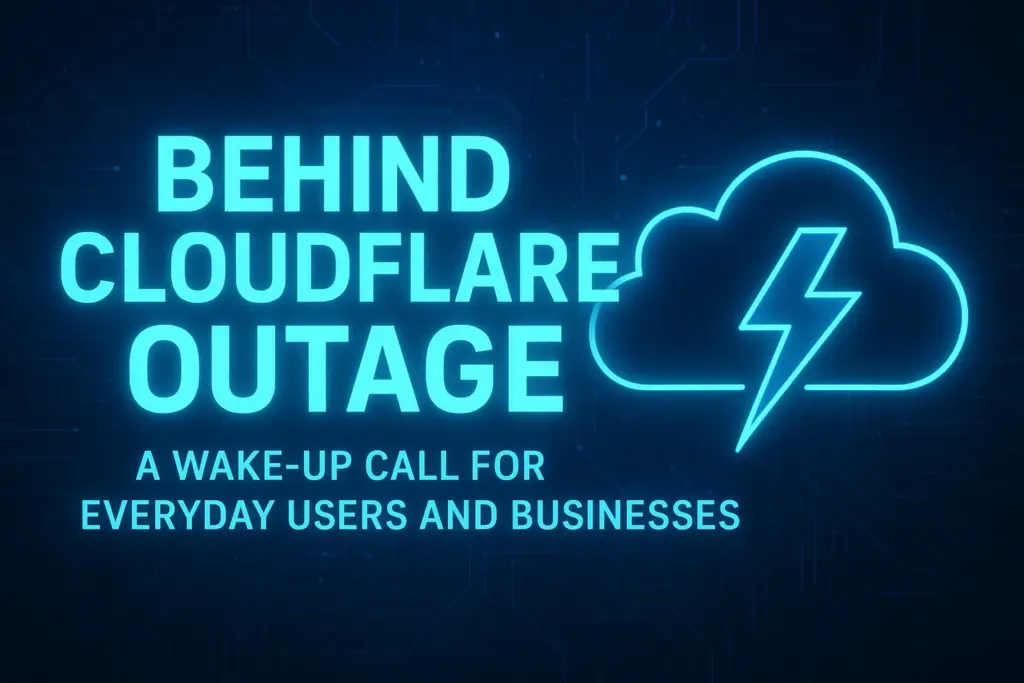On the morning of November 18 (ET), a sudden infrastructure failure caught millions of internet users off guard. Whether you were opening ChatGPT for work inspiration or refreshing X (Twitter) for breaking news, you were instead met with cold, unhelpful error messages.
Your Wi-Fi wasn’t broken. Your apps weren’t malfunctioning. The truth was far more serious—a major Cloudflare outage had disrupted key parts of the internet’s backbone. This global incident didn’t just cut users off from their AI assistants; it brought digital operations across countless businesses to a complete halt.
What Is Cloudflare, and Why Does a Cloudflare Outage Have Such Massive Impact?
For most people without a technical background, the name Cloudflare may feel unfamiliar. Yet you rely on it every single day—CAPTCHA human verification, for example, is one of its most widely encountered services.

In simple terms, Cloudflare is the “traffic controller” of the internet, sitting between a website’s visitors and its servers to route traffic efficiently and securely. Its core responsibilities include:
- Website security: Protecting online assets from malicious activity such as DDoS attacks, bot abuse, and intrusion attempts.
- Content acceleration: Improving speed, security, and reliability through a global network.
- Reliability enhancement: Maintaining uptime with scalable infrastructure to prevent outages.
Approximately 20% of the entire internet relies on Cloudflare. Everything from AI platforms like ChatGPT, Gemini, Und Claude, to social platforms like X (Twitter), to even McDonald’s in-store ordering systems, depends heavily on Cloudflare’s stability.

What Caused This Cloudflare Outrage?
Entsprechend Cloudflare’s official incident report, this global failure originated from what was supposed to be a routine software update.
During a normal deployment, engineers introduced a flawed configuration rule. This rule caused an unexpected data anomaly when generating security configuration files used for threat detection and traffic management. The files ballooned in size, exceeding system limits and triggering crashes across core services.
Because the update process is automated, this faulty configuration spread instantly across Cloudflare’s global edge network. The defective rule broke internal security logic, causing servers to incorrectly block all valid user traffic.
For end users, this translated into widespread 502 Bad Gateway Und Connection Timed Out errors across apps and websites.
Cloudflare Outage Lessons: How Businesses Should Prepare for Infrastructure Failures
This was not Cloudflare’s first major failure. In 2025 alone:
- June: Cloudflare Zero Trust and Workers KV services suffered widespread failures.
- July: A configuration error caused Cloudflare’s 1.1.1.1 public DNS to go offline for 62 minutes worldwide.
- September: Cloudflare Dashboard and related APIs were unavailable for about an hour.
Similar outages have also occurred at Amazon AWS and Microsoft Azure—no provider is immune.
Because this latest Cloudflare outrage happened during peak work hours, it resulted in enormous financial losses. Graeme Stewart from California-based Check Point Software commented:
“Many organizations still put all critical services through a single path and lack a truly effective backup.”
But the problem does have solutions.
For Large Enterprises: Cloudflare Outage Preparedness with Multi-Layer Defense
Well-funded organizations should implement a multi-cloud strategy to minimize the risk of downtime:
- Multi-Cloud Redundancy: Combine Cloudflare with alternatives like AWS CloudFront or Akamai.
- Automated Failover: Automatically redirect traffic to backup providers the moment Cloudflare goes down.
- Own Core Infrastructure: Critical data and key business logic shouldn’t rely entirely on third-party SaaS.
- Regular Disaster-Response Drills: Ensure smooth switchover when outages occur.
For Small Businesses: Practical Steps When Cloudflare Outages Happen
Smaller organizations with limited budgets can still reduce risk:
- Local Data Backups: Don’t keep key customer or financial data solely on cloud SaaS platforms. Export and back up regularly.
- Plan B Communication Channels: If your team relies only on Slack or Discord, an outage can cut all communication. Maintain backups such as phone lists, group chats, or email groups.
- Own Your Customer Audience: If your business relies solely on X or Facebook, a platform outage can erase your customer access. Build an email list—it’s still the most reliable form of customer communication.
- Have a Manual Contingency Plan: Prepare offline workflows to keep operations running when digital tools fail.
Deeper Reflection Beyond the Cloudflare Outage: What Is Our Value in the AI Era?
The most startling reaction after the outage wasn’t the technical failure itself—but the panic on social media:
“ChatGPT is down. I don’t even remember how to write an email anymore!”
This reveals a deeper societal issue: We have become more dependent on AI than ever before.
AI is undeniably powerful—but it survives under incredibly fragile conditions: electricity, servers, bandwidth, GPUs. A glitch in any of these instantly renders it useless.
AI excels at gathering and synthesizing information. It learns from massive datasets, recognizes patterns, and generates seemingly perfect responses. But if humans stop thinking independently, AI stops evolving too. Without human creativity, AI’s answers eventually become repetitive and uninspired.
Most importantly, AI can generate ten marketing strategies — but choosing which one actually works still relies on human instinct, experience, and judgment. This decision-making ability is something algorithms can’t replicate.
Technology will continue to advance, and AI may surpass traditional tools. But in circumstances where the physical environment collapses—technical failures, natural disasters, or unexpected disruptions—human intuition, creativity, and lived experience remain irreplaceable.
It is these inherently human experiences—rooted in emotion, intuition, and embodiment—that AI running on silicon chips still cannot emulate. And that is why humans remain essential, even in the age of generative AI.



